I slept soundly at the head of Ashford Canyon, two days of driving and hiking finally catching up to my aging body. Knowing that I'd have another long hike - and steep climb - ahead of me for the day, I spent a few minutes around camp, soaking in the sunrise and enjoying the shade that I knew I'd long for as the day went on.
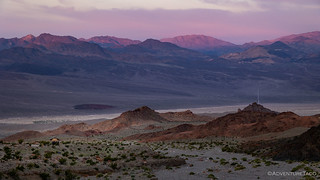
With the Tacoma still cool in the shade, a little glow on the Owlsheads, just as the sun is cresting the horizon.

As I was eating my breakfast, I spotted this little guy near camp.

Eleven minutes after first-light-on-the-mountains, the sky had changed, and Telescope Peak was gleaming.
Even so, it was just before 7:00am when I started down the alluvial fan, past the spot where I'd fought a tiny dinosaur for my life the previous afternoon. My hope was to reach the location where I'd leave the Tacoma on the side of Badwater Road and head back up into the Black Mountains before it was bathed in sun, but I could tell even as I descended the fan that I was going to be too late!

Morning light on the Owlsheads.

I hadn't gone far before I was breaking out the solar panels - more as a windshield shade than power generator - and getting set to head back into the hills.
I'd considered beginning my hike from a location along the road to Ashford Canyon - which had a point-to-point distance that was shorter than my chosen trailhead - but if I've learned one lesson in Death Valley, it's that hiking across an alluvial fan is so much harder than hiking up, that I'll happily walk several miles further in order to avoid the constant undulations of a cross-fan route. Never again do I want to repeat the hiking part of our exploration of Military Canyon, coincidentally, not far from my current location.
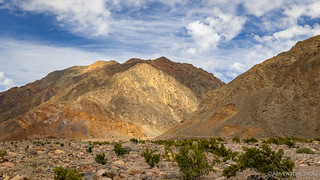
It doesn't look far, but if I've learned one lesson in Death Valley, it's that distances are deceiving.
Technically I suppose, I've learned a few lessons in Death Valley - or at least been exposed to them - and I'd have a chance to put my don't-climb-dry-falls-you-can't-climb-down lesson from the previous afternoon in a few short hours. 

Twenty minutes later, it must be getting closer. Right?
Walking up the fan, I startled a few lizards, one of them so eager to put distance between the two of us - was my body odor really so terrible? - that he performed what could only be described as a gymnastics tumbling pass in his effort to get away.


I've always loved catching lizards, and after following this one to an easily moved rock, I soon convinced him that he was "my friend." (zebra tailed)

Like the lizard I'd seen as I hiked Borax BM, this one also had a flowery garden. (sand verbena)

I noticed that the stripes wrapped all the way around his tail, which I thought was pretty cool.
Surprised at how docile it was in my hand, I probably ended up with a few dozen photos of the lizard before I set him back down and realized that he was just going to sit there - poised on a rock - for me to keep snapping away. Maybe he really was my friend. At some point though, even I had to move on.

An hour after I started, I had to be getting closer. Right?

Definitely closer. I think.
I finally reached the mouth of the unnamed canyon - which I'll call Tramway Canyon, since that's the name that it was given by a long-time hiker of Death Valley - an hour-and-a-half after setting off. That might seem like a long time to hike up an alluvial fan to the start of the interesting part of a hike, but I assure you that it was significantly faster than trying to make my way across the alluvial fan.
Along the way, I'd seen - as is common in these parts - tons of mining junk that had washed out of the canyon over the years, and as I entered the mouth of the canyon I got my answer to where several 4x16" by 30-foot-long boards originated.

As the large planks are washed away, this parking platform won't be around forever.
Also a the mouth of the canyon, the lower end of an aerial tramway - one of several tramways that helped name this place - also clung to the side of the lower canyon wall.
Knowing that - pending the dry fall situation further up the canyon - this might be the only real mining paraphernalia I be able to see up close, I wandered over to take a closer look.

Notice the rust stain from years of water dripping down off the cable.

Anchored to the rocky base of the platform, the 1-inch cable stretched high over the wash.

The wheels from an old tram cart.

Anyone need a good old USA-made jerry can? Minor surface rust only.
After poking around a bit, I worked my way off the platform via a rather rickety set of stairs that led to the wash and turned my attention to the canyon. Here, I knew I'd either be turned around in slightly under half a mile, or I'd find myself scrambling up a 45° scree field towards mine workings, a mile up the canyon.
A few minutes later, I entered the first narrows.

Here we go!
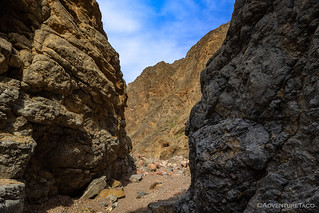
I always love the variation in color between rocks that are so close together.
I reached the first dry fall after only a few minutes. A quick glance and I knew this one would be no problem to scale in either direction. Still, knowing that I might not make it past the second, larger fall, a little further on, I was in no rush to leave this one behind, especially given the warm light radiating from above and graceful shape of the canyon.
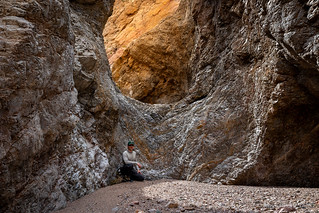
The first fall.

OK man, that's a little dramatic don'tcha think?

Beyond the first fall, texture and light were once again on full display.
The second - and much larger - dry fall was 200 feet further up the wash, but not visible from the first. I'd heard reports of this fall from two fellow explorers, the first of whom was forced to turn around when they couldn't find any safe way up the fall. That was in 2016, but I'd heard that by 2019 a thin rope had been draped over the sharp rock. It wasn't much, but it was enough to make the climb - and exploration of the upper canyon - possible.
Now, I'll be the first to admit that I wasn't sure I'd want to use a thin rope that I hadn't personally secured after more than 5 years in the Death Valley sun, but I figured I'd cross that bridge when I got to it - which was nearly immediately. As I rounded a corner in the narrows and was presented with a tall wall of rusty-orange quartz.
To my surprise - and delight - I saw a "rope" hanging down that was not the rope from 2019. In fact, I couldn't quite tell when I saw it initially, but it appeared to be a steel cable - a fact I quickly confirmed - which I thought would be a fantastic assist, assuming it was well anchored.

Hope this thing holds.
Only as I got about three-quarters of the way to the top did I realize that even the steel cable was on borrowed time.

Hmm, that's not reassuring.
I probably didn't have anything at all to worry about - what was left of the cable could likely hold ten times my weight or more - but I was still glad once I'd reached the top, and even happier to successfully downclimb the fall on my return!

The view down-canyon from the top of the dry fall.
There'd be no more obstacles as I continued through the upper narrows, allowing my anticipation to grow as I neared the Scallywag Mine.

I found this baseball-sized rock - a white core wrapped in red - in a small alcove above the fall.

A colorful ascent.

High above me, clinging precariously to the canyon wall, an old ore bin and tram terminal. How the heck was I going to get up there?
After a few more turns, a lower ore bin came into view. This, it turned out, wasn't the end of the aerial tram but rather a bin for a chute that started several hundred feet above. On it, the "Scallywag Mine" road sign blazed a brilliant green and I approached with a smile on my face.

Ore bin.

Scallywag Mine.
Technically, the Scallywag Mine - so called these days for obvious reasons - was worked as the Jubilee Lead Mine, and as with the vast majority of mines, was unprofitable. What's most surprising to me was all the work that went into this place for what must have been, "a little bit of lead." Hauling up all the materials alone would have been a crazy amount of work, but stringing the cables - which must weight tens of thousands of pounds - that is a level of effort I simply can't imagine.

Across the wash from the lower ore bin, a work room had been blasted into the canyon wall.
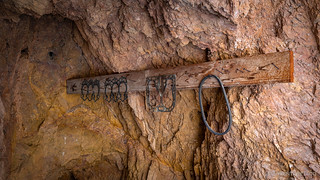
Gasket rack.

From this angle, the pipeline that carried ore from the workings above is more clearly visible.
Before trying to find a way up to the workings, I wanted to check out a few more rusty bits of machinery I saw laying on the ground a little further up the wash. Then, having scoped out the hillside, it seemed to me that the best way to reach the infrastructure above was to follow the old water pipeline, using it as necessary for stabilization over the extremely steep, loose terrain.

If I'd had more time, I'd have wandered even further up this wonderful wash.

The trucks from an old ore cart. Too bad they weren't on a length of track so I could push them along!

It was neat to see an old aerial tram cart sitting on the ground next to the lower tram terminal.
By the time I completed my scramble up the face of what seemed to be a near-vertical cliff - thankful for the water pipeline that gave me something reasonably solid to haul myself up - I found myself 50-feet or so above the first working, with views that could only be described as "wow."

Up canyon.

Down canyon, and down to the first - precarious - working.

Intriguing!
Picking my way down a drainage to the platform of the first working, I found myself wondering how the guys who worked this mine on a regular basis got around. There must have been so much up and down, down and up. Death-defying feats, even on the best of days. And remember, they weren't even after gold, they were after lead!


On the platform, the final few feet to dump an ore cart seemed a little dangerous.

These guys were obviously not plumbers.

This time, I'd remembered to bring my flashlight!
Wandering into the working, I was curious if the difficulty of getting to this mine would mean that were more artifacts than in some others I'd explored. In the end, I suppose there were a few more, but I wasn't lucky enough to find - for instance - an ore cart to push along the rails!

I could make a joke about Trojan and Explosive, but I'll leave that to the reader.

At the end of the adit, a shaft - and strange cylindrical metal chute - ascended to the upper levels, a cool breeze constantly flowing from one level to the next.
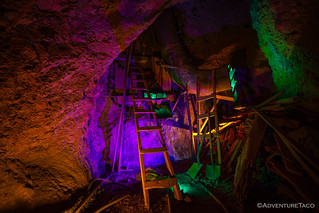
I couldn't help but bust out the LEDs for a little light show.
Eventually, it was time to head back. Not only had I gotten to explore the upper canyon - something I was fully prepared to not do if I couldn't make it beyond the second dry fall - but reaching the workings was a cool bonus. As such, my spirits were high as I retraced my steps through the narrows, worked my way down the dry fall one final time, and popped out the mouth of the canyon and headed down the alluvial fan towards the Tacoma.

The light on my return trip through the narrows might have been even nicer than on my way up.

The first time I've seen the flower of a Desert Rock Nettle, a horrible plant. Every leaf sticks to anything it touches, and breaks into a million pieces if you try to remove it.

As I descended toward the Tacoma, an F-18 screamed by - much too high - overhead.

Looking back at what had been a great adventure.
And with that, my first trip to Death Valley in more than a year was complete. It'd been warmer than I expected, but as always I'd enjoyed myself every minute of the way. Well, except for the incident with the dry falls, and my near-consumption by a chuckwalla!
And if all that wasn't enough, I wasn't headed home quite yet. Rather, I was headed south to meet a semi-random guy I'd met on the internet. For he'd promised that it would be The Perfect Day for Something Stupid, and there was no way I was going to pass up a sales pitch like that!
The Whole Story



Another wonderful adventure, as always, thanks for sharing!
You're welcome!
Easily one of my most favorite places in the valley, did a video there last year, too old to do the climb up to the mine.
Once again, looks like a great adventure. The little yellow flower is False Monkeyflower (Mimetanthe pilosa). The plant that stuck to everything is Desert Rock Nettle (Eucnide urens). UJ
I've been wondering what that Desert Rock Nettle is, thanks! Man, that plant is a huge PITA. We ran into it in the Inyo Mountains (from the Saline side) and both of us spent a good amount of time trying to grind it off of our shoes. Terrible stuff!
About five years ago, that old cable was a rope. I guess it rotted away in the desert sun.
Yes, I was expecting a rope. Was thrilled to find the cable, but it doesn't have long for this world, either!